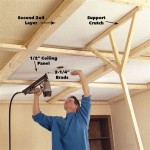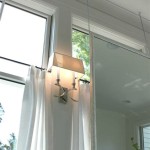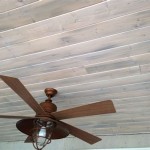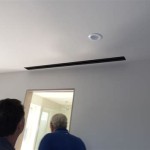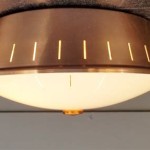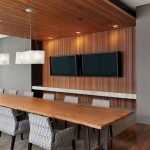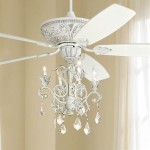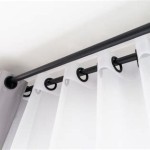How To Insulate Your Basement Ceiling for Sound Dampening
A basement, often located below the main living areas of a house, can be a significant source of noise transmission. Footsteps, conversations, and entertainment sounds from upstairs frequently travel through the floor joists and into the basement. Conversely, noise generated in the basement, such as from a home theater, workshop, or recreational activities, can easily disturb occupants on the upper floors. Addressing this noise problem frequently involves insulating the basement ceiling. Proper insulation not only improves the acoustic environment of both the basement and the floors above but can also contribute to improved energy efficiency and temperature regulation.
Several factors contribute to the effectiveness of basement ceiling insulation for sound dampening. The type of insulation material used, the method of installation, and the overall structural characteristics of the floor-ceiling assembly all play crucial roles. A strategically implemented insulation solution can significantly reduce the transmission of airborne and impact noise, creating a more comfortable and peaceful living environment.
This article will provide a comprehensive guide to insulating a basement ceiling for sound dampening, covering various insulation options, best practices for installation, and considerations for achieving optimal results.
Understanding Sound Transmission and Insulation Principles
Before delving into the specifics of insulation, it is important to understand the basics of sound transmission and how insulation works to mitigate it. Sound, as a form of energy, travels through air and solid materials as vibrations. When sound waves strike a surface, they cause the surface to vibrate, which in turn transmits the sound energy to the adjacent space. Noise transmission between floors primarily occurs through two mechanisms: airborne noise and impact noise.
Airborne noise refers to sound that travels through the air, such as voices, music, or television sounds. This type of noise can easily penetrate gaps and cracks in the floor-ceiling assembly, as well as vibrate the joists and subfloor. Impact noise, on the other hand, is generated by direct contact with the floor, such as footsteps, dropped objects, or furniture movement. This type of noise is transmitted through the structure itself, creating vibrations that radiate through the joists and into the basement space.
Insulation materials work to reduce sound transmission by absorbing and dampening sound waves, preventing them from propagating through the structure. The effectiveness of an insulation material in reducing sound transmission is typically measured by its Sound Transmission Class (STC) rating. The STC rating indicates the material's ability to block airborne noise, with higher numbers indicating better performance. Similarly, the Impact Insulation Class (IIC) rating measures the material's effectiveness in reducing impact noise. When selecting insulation for sound dampening, it is generally recommended to choose materials with higher STC and IIC ratings.
In addition to the insulation material itself, the overall construction of the floor-ceiling assembly plays a critical role in sound transmission. A thicker and more massive structure will generally provide better sound isolation than a thinner, lighter one. Adding mass to the floor-ceiling assembly, such as by installing a layer of dense gypsum board or using resilient channels, can further enhance its sound dampening capabilities.
Choosing the Right Insulation Material for Sound Dampening
Several types of insulation materials can be used to insulate a basement ceiling for sound dampening, each with its own advantages and disadvantages. The choice of material will depend on factors such as budget, desired level of sound reduction, ease of installation, and environmental considerations.
Fiberglass Insulation: Fiberglass insulation is a common and relatively inexpensive option for sound dampening. It is made from spun glass fibers and is available in batts, rolls, and loose-fill forms. Fiberglass batts and rolls are easy to install between floor joists, while loose-fill fiberglass can be blown into cavities for better coverage. Fiberglass insulation is effective at absorbing airborne noise, but it is less effective at reducing impact noise. Its STC rating is typically in the range of 30-40.
Mineral Wool Insulation: Mineral wool insulation, also known as rock wool or slag wool, is another popular choice for sound dampening. It is made from recycled materials such as slag or rock and offers excellent sound absorption properties. Mineral wool is denser than fiberglass and provides better STC and IIC ratings, typically in the range of 45-55. It is also more resistant to fire and moisture than fiberglass.
Spray Foam Insulation: Spray foam insulation is a high-performance option for sound dampening. It is applied as a liquid that expands and hardens, filling gaps and cracks to create an airtight seal. Spray foam insulation provides excellent sound absorption and can significantly reduce both airborne and impact noise. There are two main types of spray foam: open-cell and closed-cell. Closed-cell spray foam is denser and provides better sound insulation than open-cell spray foam, with STC ratings typically in the range of 40-50. However, it is also more expensive.
Acoustic Panels: Acoustic panels are designed specifically for sound absorption and are often used in home theaters, recording studios, and other spaces where sound control is critical. They are typically made from fiberglass, mineral wool, or foam and are covered with fabric. Acoustic panels can be installed on the basement ceiling to absorb sound reflections and reduce reverberation, improving the overall acoustic environment. While effective they are not as effective at stopping sound transmission through the floor as insulation installed between the joists.
Resilient Channels: Although not insulation per se, resilient channels are metal strips that are attached to the floor joists before installing the drywall or ceiling finish. These channels decouple the drywall from the joists, reducing the transmission of vibrations and significantly improving the sound isolation of the floor-ceiling assembly. Combining resilient channels with insulation can achieve exceptional sound dampening results.
Installation Techniques for Effective Sound Dampening
Proper installation is crucial for maximizing the sound dampening effectiveness of basement ceiling insulation. The following steps outline best practices for installing different types of insulation for optimal results:
Preparation: Before starting the installation, thoroughly inspect the basement ceiling for any gaps, cracks, or air leaks. Seal these imperfections with caulk or expanding foam to prevent sound from leaking through. Ensure that the area is clean and free of debris.
Fiberglass or Mineral Wool Batt Installation:
Measure the width of the floor joist cavities and cut the insulation batts to the appropriate size. Ensure that the batts fit snugly between the joists without being compressed. Compression reduces the insulation's effectiveness.
Wear appropriate safety gear, including a dust mask, gloves, and eye protection to avoid skin and respiratory irritation.
Install the batts facing the paper or foil vapor barrier towards the living space (upstairs). This helps to prevent moisture from condensing within the insulation.
For enhanced sound dampening, consider installing two layers of insulation batts, with the first layer friction-fit between the joists and the second layer installed perpendicular to the first.
Spray Foam Installation:
Spray foam installation is best left to professionals, as it requires specialized equipment and training.
Ensure that the area is properly ventilated during and after the installation to allow the foam to cure and dissipate any fumes.
The spray foam should be applied evenly and completely fill the joist cavities for optimal sound dampening and thermal performance.
Acoustic Panel Installation:
Acoustic panels can be easily installed on the basement ceiling using adhesives or mounting hardware.
Position the panels strategically to absorb sound reflections and reduce reverberation. Consider placing them in areas where sound is most likely to be generated or reflected, such as near entertainment systems or workspaces.
Resilient Channel Installation:
Attach the resilient channels perpendicular to the floor joists, typically spaced 16 or 24 inches apart.
Use screws to attach the channels to the joists, ensuring that the screws do not penetrate the joists too deeply. The goal is to allow the channel to vibrate independently of the joists.
Install drywall or other ceiling finish onto the resilient channels, using screws that are long enough to penetrate the drywall and the channel but not the joists.
Additional Considerations:
Consider using a combination of insulation materials and techniques to achieve the desired level of sound dampening. For example, combining mineral wool insulation with resilient channels can provide excellent results.
Pay attention to detail during the installation process to ensure that all gaps and cracks are properly sealed. Even small openings can significantly reduce the effectiveness of the insulation.
Consider the potential for moisture accumulation within the insulation and take steps to prevent it. Use a vapor barrier on the warm side of the insulation (towards the living space) and ensure that the basement is properly ventilated.
By carefully selecting the appropriate insulation material and following proper installation techniques, it is possible to significantly reduce sound transmission through the basement ceiling, creating a more comfortable and peaceful living environment for all occupants.

Soundproofing Ceilings How To Soundproof A Ceiling

Soundproofing A Ceiling Unfinished Basement Ideas Renovations

Soundproofing A Home Work Technical Details Two Teaching S

How To Soundproof A Basement Ceiling

7 Ways To Soundproof A Ceiling That Really Work Sound Proofing Insulation

Best Insulation For Soundproofing Your Ceiling Renoviso

Soundproofing Basement Insulation Services In Denver Co

What To Know About Soundproofing A Basement Ceiling

Ceiling Soundproofing Secrets Everything You Need To Know

Soundproofing Canadian Foam Insulation Spray
Related Posts

